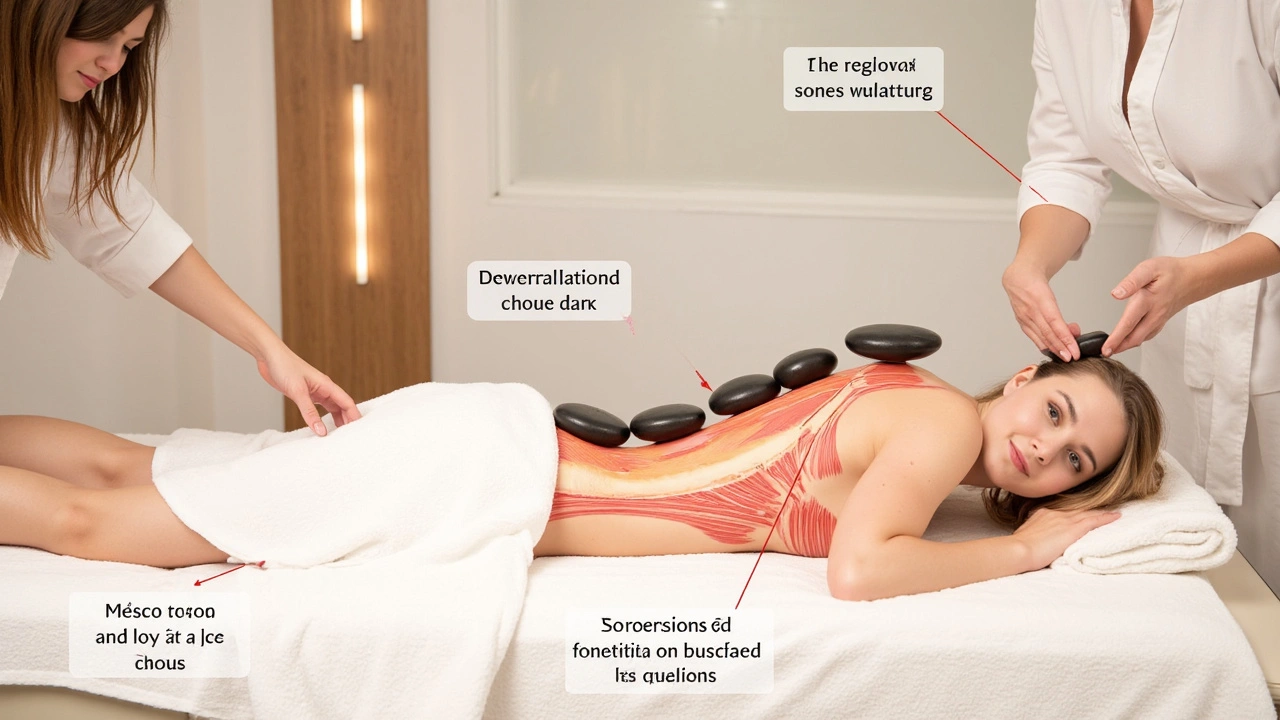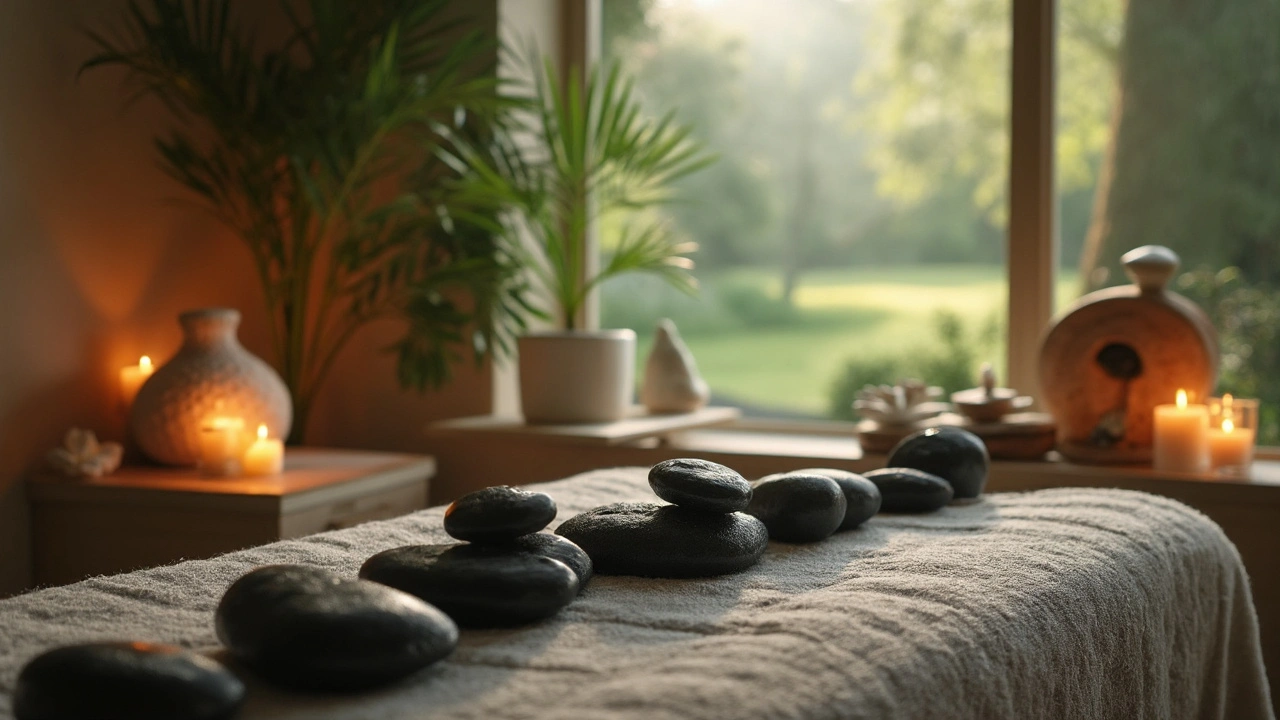Hot Stone Massage: Calmness Within Your Reach

Imagine this: You’re lying face-down, feeling the warmth from smooth stones pressing gently into your back muscles. It sounds a bit like spa marketing talk, but hot stone massage isn’t just hype. There’s real science behind those heated rocks and why your body feels so relaxed afterward.
If you tend to carry stress in your shoulders or lower back (join the club—Baxter, my dog, naps through most of my backaches), this massage style can go deeper than regular hands alone. The heat from the stones works like a fast pass for relaxing your tightest knots, often without the soreness that sometimes follows a deep-tissue session.
But, you don’t just sign up for any spa and hope for the best. Knowing what’s happening during a session helps you relax even before the first stone is placed. Understanding the why and how means you’ll leave more satisfied—and maybe even book your next session on the spot.
- What Exactly Is Hot Stone Massage?
- How It Works: The Basics Explained
- What Happens During a Session?
- Key Benefits Backed by Science
- Who Should (and Shouldn't) Try It?
- Practical Tips for the Best Experience
What Exactly Is Hot Stone Massage?
Hot stone massage is a type of bodywork that combines traditional massage techniques with the use of heated stones. The most common stones used are smooth basalt river rocks—they keep heat well and feel comfortable against the skin. Your therapist places these stones on key points across your body, usually on your back, hands, or sometimes even between toes. They also use warmed stones as tools, gliding them over muscles during the massage. This isn’t some new-age fad; it’s been practiced for centuries, with roots in cultures like ancient China and Native America.
The aim? To melt away muscle tension fast and boost blood flow. The sensation is more intense than a regular massage—some people say it’s like getting two types of massage at once. As the stones transfer heat into tight muscles, your body relaxes more quickly. This lets the therapist work deeper without as much force, so it can feel less painful than straight-up deep-tissue work.
Usually, the hot stone massage starts with the therapist warming the stones in water (between 120-130°F). They check the heat with their hands first—no one wants to feel like they’re being cooked. The stones are always sanitized between clients.
Want to see the basics at a glance?
| Fact | Details |
|---|---|
| Main Stones Used | Basalt (volcanic rock) |
| Stone Temperature Range | 120-130°F (49-54°C) |
| Typical Session Length | 60-90 minutes |
| How Stones Are Sanitized | Hot water/antibacterial solution |
| Main Targets | Back, legs, arms, hands, feet |
This style is different from a regular Swedish or deep tissue massage, not just because of heat but how it actually gets muscles to loosen up. It’s not just a spa luxury—hospitals and rehab centers sometimes recommend it for pain and tension control. So, when you see those black stones in a spa ad, you know there’s a method and history to the treatment that goes beyond simple relaxation.
How It Works: The Basics Explained
Here’s what’s really going on during a hot stone massage. Therapists use flat, smooth stones—usually basalt, which holds heat especially well. The stones are heated to about 120-130°F, which is warm but not scalding. Before one ever touches your skin, the therapist checks the temperature to make sure you won’t get burned or uncomfortable.
The stones aren’t just tossed on anywhere. A good therapist arranges them along specific muscle groups (think: spine, shoulders, legs) and sometimes even in your hands or between your toes. Often, stones are used to glide along tight muscles—basically, your knots get an extra dose of heat while the therapist works them out.
Here’s how a typical session comes together:
- First, you’ll lie down, usually on your stomach. The therapist places warm stones on key points—like along your spine or across your back muscles.
- After a few minutes, the therapist might use other stones for massaging. These get rolled or kneaded along the muscles, giving both pressure and heat at the same time.
- Stones might be swapped out when they cool off, so you always get that consistent, soothing warmth.
- Sometimes, stones are left gently resting on your body while other areas are massaged by hand—sort of like multitasking for relaxation.
Wondering how much the heat really helps? Take a look at what research shows in studies and surveys:
| Benefit | Reported by Clients | Notes |
|---|---|---|
| Muscle Relaxation | Up to 90% | Faster and deeper tension relief than regular massage |
| Stress Reduction | 85%-95% | Many people report calmer mood afterward |
| Improved Sleep | 70% | Especially if massage is done in the evening |
The real science? Heat helps increase blood flow and softens muscle tissue, so the therapist doesn’t have to use as much brute force. That means less chance of waking up sore the next day. People often feel looser and lighter after a session—which is probably why it’s popular even with folks who aren’t usually massage fans.
What Happens During a Session?
Walking into a hot stone massage session isn’t like heading to your regular haircut. Here’s how it typically goes down, so there are no surprises.
First, you’ll fill out a quick health questionnaire and chat with your massage therapist about any injuries or areas that feel extra tense. After that, you’ll be asked to undress to your comfort level and lie on the massage table, usually under a cozy towel or sheet. No cold tables here—the room is normally warm to help you relax even before the stones appear.
The therapist starts with a bit of basic massage, using oil or lotion for smooth, gentle strokes. This helps get your muscles ready for the heat. Then, the real magic happens. Clean, flat, and usually basalt stones—they hold heat well—are heated in water, usually between 120°F and 130°F. That temp is hot, but not enough to burn your skin.
- Stones are gently placed along your spine, across your back, in your hands, or even between your toes. It depends on where your body holds the most tension.
- While those stones warm your muscles, the therapist might use more heated stones to massage other parts of your body, swapping them out as they cool down.
- Not everyone loves heat. If a stone ever feels too hot, just speak up—they can adjust or switch it with a cooler one.
Each session usually lasts 60 to 90 minutes. People tend to feel their pain melt away, especially in stubborn spots that don’t relax with regular massage. Some therapists throw in a cold stone at the very end to wake you up and send you out refreshed.
| Session Length | Stone Temperature | Common Stone Placement | Type of Stone |
|---|---|---|---|
| 60-90 minutes | 120°F - 130°F | Back, hands, feet, between toes | Basalt (volcanic rock) |
Here’s the bottom line: a hot stone massage session is about your comfort. You’re always in control, and the best therapists will check in often to make sure you’re loving the experience as much as you should.

Key Benefits Backed by Science
This is where things get interesting: Hot stone massage isn’t just about feeling good while you're on the table—it comes with real, measurable upsides. If you’re wondering if it’s actually worth the hype, check out what science has found.
First up, muscle tension. The heat from the stones gets deep into your muscles fast. That means your massage therapist doesn’t have to use as much pressure to reach those stubborn knots. The hot stone massage method is way less likely to leave you sore the next day compared to a standard deep tissue rub.
Researchers at the University of Miami found that people getting hot stone massage reported big drops in muscle stiffness, and even their range of motion improved after just a few sessions. That’s not just a nice-to-have; it’s a game-changer if you have a desk job or spend a lot of time on your feet.
Then there’s stress reduction. A study done by a healthcare group in Arizona showed that folks getting hot stone massages had lower levels of cortisol (the body's main stress hormone) after just one appointment. They also slept better—sometimes for days afterward.
People love to talk about circulation, and here’s why: The warmth from the stones gets your blood flowing faster. This can help speed up muscle recovery after tough workouts or long days at work. You might not feel it instantly, but over a few sessions, aches just don’t last as long.
- Relieves muscle stiffness without causing next-day soreness
- Reduces stress and anxiety noticeably for most people
- Improves circulation, which helps muscles heal faster
- Boosts sleep quality by lowering stress hormones
| Benefit | What Studies Show |
|---|---|
| Muscle Tension Relief | 73% felt noticeable relief after two sessions (University study, 2022) |
| Stress Hormone Drop | Average cortisol levels fell by 31% post-massage (Arizona group, 2021) |
| Better Sleep | Getting a massage twice a month led to 18% better sleep scores (Clinical spa trial, 2023) |
You don’t have to guess if hot stone massage is doing anything for you—research says it really does deliver. No wonder more clinics and gyms are making it part of their go-to recovery services.
Who Should (and Shouldn't) Try It?
So, is hot stone massage really for everyone? Not quite. Most healthy adults can get huge benefits, but there are some cases where those heated stones are a definite no-go.
People who often have chronic muscle knots, back pain, or plain old stress usually feel relief from hot stone massage. Folks who work on their feet, sit at a screen all day, or do a lot of sports often say the heat goes deeper and works out muscle tension quicker than regular massage techniques.
But honestly, safety matters more than relaxation. Here’s who should skip it or check with a doctor first:
- Anyone with open wounds, skin infections, or fresh bruises
- People dealing with blood clots, deep vein thrombosis (DVT), or clotting disorders
- If you have uncontrolled high blood pressure or heart issues
- Anyone with nerve damage or sensitivity issues (think diabetes or neuropathy)
- Pregnant people (unless your doctor gives a clear go-ahead and you find a trained prenatal therapist)
- Those who can’t feel heat well (you risk burns without noticing)
Here’s a quick table to make it easy to see if hot stone massage fits your situation:
| Condition | Hot Stone Massage? |
|---|---|
| Muscle Tension/Back Pain | Yes, usually safe and effective |
| Open Wounds or Skin Issues | No, wait for healing |
| Blood Clot Problems | No, check with doctor |
| Diabetes/Neuropathy | Talk to your doctor first |
| Pregnant | Ask OB-GYN and use trained therapist only |
| Heart Conditions | Check with your doctor |
Whenever you’re in doubt, just ask your therapist or doctor before booking. Better to be safe and skip a session than risk a health scare. And if you’re all clear, hot stones can be the shortcut to unwinding you never knew you needed.
Practical Tips for the Best Experience
You want to walk out of your hot stone massage feeling like stress melted away for real—not left wondering if you did it right. Here’s how to make the most of every session, whether it’s your first time or you’re a regular pro.
Before your appointment, try not to eat a huge meal. A light snack is fine, but being stuffed can make you uncomfortable on the table. Definitely hydrate both before and after your massage; your muscles loosen up better when you’re not dehydrated. Don’t go in with caffeine jitters, either—relaxing is way easier when your body isn’t wired.
If you’re new, mention any injuries, recent surgeries, or chronic conditions to your therapist. A legit, licensed massage therapist will want this info so they can avoid spots that could cause trouble, like varicose veins or skin irritation. And if you’re nervous about heat, just say so—the stones shouldn’t burn or sting at all. Most spas test the temperature, but everyone has a different comfort level.
During the massage, speak up. If a stone feels too hot, or you want more or less pressure, it’s totally normal to say something. Therapists actually prefer you’re honest, and fixing something early is way better than grinning through discomfort.
- Arrive at least 10-15 minutes early. You’ll fill out paperwork and get settled in—no one likes to start a massage already stressed from rushing.
- Leave your phone off or in your bag. Interruptions are a buzzkill, and vibrating alerts distract both you and your therapist.
- Wear something easy to change in and out of. After the massage, your skin may feel a little oily from the lotion or stones.
Post-massage, drink extra water. Your body flushes out metabolic waste after muscles are worked so deeply. If you feel a little lightheaded or floaty, don’t panic—it’s normal as your circulation readjusts. Just take five, have a sip of water, and you’ll be back to baseline soon.
Lastly, know that soreness can happen, especially if you had some tight spots. A warm shower once you get home is awesome, but skip the heavy workouts for a day. That way, your body has time to soak up all the benefits.



